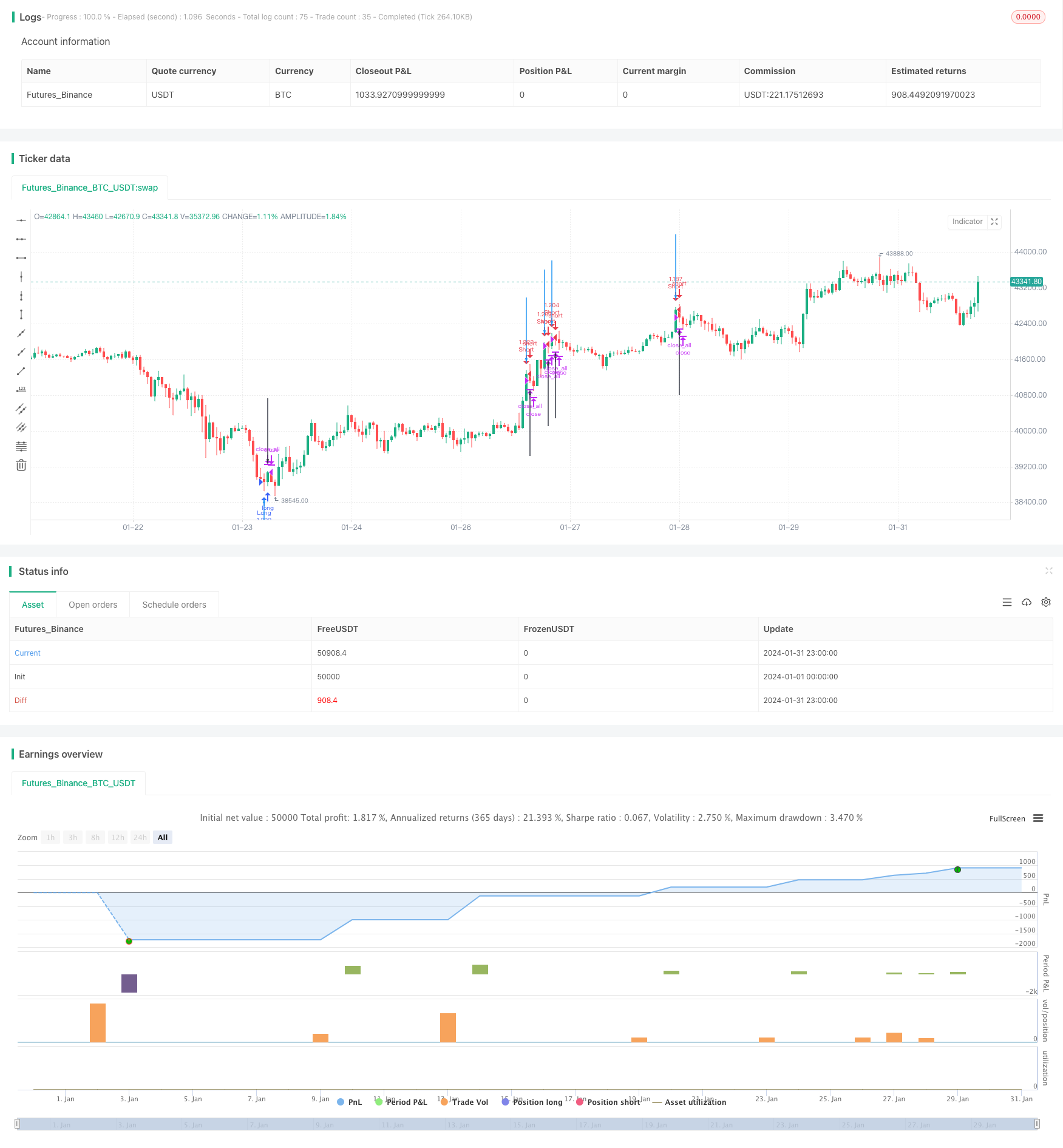
概述
该策略通过WaveTrend指标判断价格趋势和超买超卖情况,结合RSI指标过滤信号,采用趋势追踪方式,在超买超卖位做反向操作。
策略原理
该策略使用WaveTrend指标判断价格趋势方向。WaveTrend指标基于Rainbow指标改进而来,通过计算Heikin-Ashi均线和价格绝对值之间的差值,来判断价格趋势方向。结合RSI指标判断超买超卖情况发出交易信号。
具体来说,策略中的WaveTrend公式为:
esa = ema(hlc3, 10)
d = ema(abs(hlc3 - esa), 10)
ci = (hlc3 - esa) / (0.015 * d)
wt = ema(ci, 21)
其中,esa是计算的Heikin-Ashi均线,d是Heikin-Ashi均线和价格绝对值之差的均值。ci就是所谓的适应性区间,反映价格波动力度。wt是ci的均线,判断价格趋势方向,多为空头的关键指标。
RSI指标用于判断超买超卖,代码中RSI的计算公式为:
rsiup = rma(max(change(close), 0), 14)
rsidown = rma(-min(change(close), 0), 14)
rsi = rsidown == 0 ? 100 : rsiup == 0 ? 0 : 100 - (100 / (1 + rsiup / rsidown))
其标准值为0-100,高于70为超买区,低于30为超卖区。
结合这两个指标,当RSI低于25,WaveTrend低于-60时为超卖区,做多信号;当RSI高于75,WaveTrend高于60时为超买区,做空信号。
优势分析
该策略具有以下优势:
- 使用WaveTrend指标判断价格趋势方向准确可靠。
- RSI指标过滤能避免不必要的交易,提高胜率。
- 采用趋势追踪方式,可以最大化捕捉价格趋势所带来的利润。
- 策略思路清晰易懂,参数设置灵活,可根据不同品种和市场调整。
- 策略实现简单,容易实盘验证,利于框架优化。
风险分析
该策略也存在一些风险:
- WaveTrend和RSI指标都存在一定滞后,可能错过价格反转点。
- 虽有过滤条件,但仍可能在震荡行情中产生错误信号。
- 追踪止损策略有待完善,无法有效控制单笔损失。
- 参数设置合理与品种特性和交易频率匹配非常关键。
对策: 1. 结合额外判断指标进行优化,提高信号准确率。 2. 加入止损策略,控制单笔损失。 3. 寻找最佳参数组合,调整策略适应市场品种。
优化方向
该策略可从以下几个方向进行优化:
更换judgment指标或增加judgment指标,优化信号的准确率。例如加入MACD,KD等判断指标。
优化参数设置,适应不同交易品种。例如调整平滑周期,寻找最佳参数组合。
加入追踪止损策略,有效控制单笔损失。例如余额百分比止损,移动止损等。
考虑不同加仓策略。例如使用马丁格尔加仓替代原有的固定数量加仓。
优化适应性区间参数,寻找最佳参数提高判断准确性。
总结
该策略整体思路清晰,使用波动力度指标判断价格趋势,并有效过滤噪音交易信号。策略优化空间较大,可从多个角度进行改进,使策略更稳定可靠。通过参数调整优化,可适应不同交易品种,值得进一步测试实盘验证。
/*backtest
start: 2024-01-01 00:00:00
end: 2024-01-31 23:59:59
period: 1h
basePeriod: 15m
exchanges: [{"eid":"Futures_Binance","currency":"BTC_USDT"}]
*/
//Noro
//2018
//@version=2
strategy(title = "Noro's WaveTrender Strategy v1.0", shorttitle = "WaveTrender str 1.0", overlay = true, default_qty_type = strategy.percent_of_equity, default_qty_value = 100, pyramiding = 10)
//Settings
needlong = input(true, defval = true, title = "Long")
needshort = input(true, defval = true, title = "Short")
usemar = input(false, defval = false, title = "Use Martingale")
capital = input(100, defval = 100, minval = 1, maxval = 10000, title = "Capital, %")
showarr = input(true, defval = true, title = "Show Arrows")
fromyear = input(2018, defval = 2018, minval = 1900, maxval = 2100, title = "From Year")
toyear = input(2100, defval = 2100, minval = 1900, maxval = 2100, title = "To Year")
frommonth = input(01, defval = 01, minval = 01, maxval = 12, title = "From Month")
tomonth = input(12, defval = 12, minval = 01, maxval = 12, title = "To Month")
fromday = input(01, defval = 01, minval = 01, maxval = 31, title = "From day")
today = input(31, defval = 31, minval = 01, maxval = 31, title = "To day")
//RSI
rsiup = rma(max(change(close), 0), 14)
rsidown = rma(-min(change(close), 0), 14)
rsi = rsidown == 0 ? 100 : rsiup == 0 ? 0 : 100 - (100 / (1 + rsiup / rsidown))
//WaveTrend
esa = ema(hlc3, 10)
d = ema(abs(hlc3 - esa), 10)
ci = (hlc3 - esa) / (0.015 * d)
wt = ema(ci, 21)
//Body
body = abs(close - open)
abody = sma(body, 10)
//Signals
bar = close > open ? 1 : close < open ? -1 : 0
overs = rsi < 25 and wt < -60
overb = rsi > 75 and wt > 60
up1 = (strategy.position_size == 0 or close < strategy.position_avg_price) and overs and bar == -1
dn1 = (strategy.position_size == 0 or close > strategy.position_avg_price) and overb and bar == 1
exit = (strategy.position_size > 0 and overs == false) or (strategy.position_size < 0 and overb == false)
//Arrows
col = exit ? black : up1 or dn1 ? blue : na
needup = up1
needdn = dn1
needexitup = exit and strategy.position_size < 0
needexitdn = exit and strategy.position_size > 0
plotarrow(showarr and needup ? 1 : na, colorup = blue, colordown = blue, transp = 0)
plotarrow(showarr and needdn ? -1 : na, colorup = blue, colordown = blue, transp = 0)
plotarrow(showarr and needexitup ? 1 : na, colorup = black, colordown = black, transp = 0)
plotarrow(showarr and needexitdn ? -1 : na, colorup = black, colordown = black, transp = 0)
//Trading
profit = exit ? ((strategy.position_size > 0 and close > strategy.position_avg_price) or (strategy.position_size < 0 and close < strategy.position_avg_price)) ? 1 : -1 : profit[1]
mult = usemar ? exit ? profit == -1 ? mult[1] * 2 : 1 : mult[1] : 1
lot = strategy.position_size == 0 ? strategy.equity / close * capital / 100 * mult : lot[1]
if up1
if strategy.position_size < 0
strategy.close_all()
strategy.entry("Long", strategy.long, needlong == false ? 0 : lot)
if dn1
if strategy.position_size > 0
strategy.close_all()
strategy.entry("Short", strategy.short, needshort == false ? 0 : lot)
if exit
strategy.close_all()